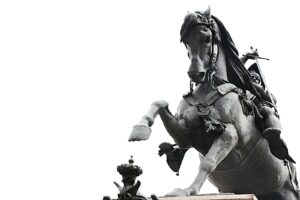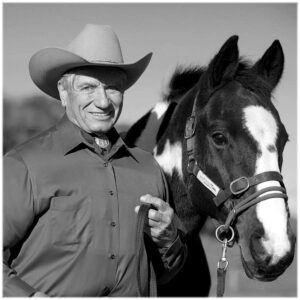
Have you ever wondered why, when we approach a horse, we do so from the left side? This age-old practice, steeped in tradition, isn’t just a random habit but a deliberate action rooted in history and practicality. For centuries, horse handlers and riders have adhered to this custom, a testament to the enduring wisdom passed down through generations. In this post, we will take a deeper look into the fascinating tradition of the left side in the equestrian world, exploring its origins, the reasons behind its persistence, and how it has shaped the relationship between humans and horses throughout history. Whether you’re an avid equestrian or simply curious about historical practices, the story of why we approach horses from the left side offers a captivating glimpse into the past.
Medieval knights and their right hands:

The convenience factor:
Fast forward a bit, and even as the age of knights waned, the practice of left-side handling continued, upheld by a very practical reason: convenience. The majority of the population is right-handed, and working with horses from the left side made various tasks more straightforward. Adjusting the bridle, placing the saddle, and mounting the horse all became easier when done from the left, allowing the dominant hand to perform the more dexterous actions.
Imagine a farmer in the 18th century preparing his horse for a day in the fields. By approaching from the left, he could use his right hand to deftly adjust the bridle and ensure a secure fit. Similarly, when placing the saddle, his stronger and more coordinated right hand could manage the weight and positioning with greater ease. Mounting the horse from the left side also allowed for a smoother and more balanced ascent, reducing the risk of startling the animal or losing footing.
This left-side tradition wasn’t just about personal convenience; it became a standard practice taught to new generations of riders and handlers. It created a uniform approach that ensured consistency and safety, whether on the battlefield, the farm, or in recreational riding. The left-side handling of horses is a perfect example of how practical considerations can shape long-standing traditions, blending historical roots with everyday functionality.
Maintaining tradition through time:
As centuries passed and knights in shining armor gave way to different forms of horsemanship, the tradition of the left side endured, seamlessly integrating into various new contexts. In the military, for example, mounted units continued to train soldiers to approach, mount, and dismount from the left side. This was not only a nod to historical practices but also a matter of uniformity and efficiency. During the American Civil War, both Union and Confederate cavalry units adhered to this custom, ensuring that all soldiers followed the same procedures, which reduced confusion and enhanced operational effectiveness.
Similarly, police units on horseback maintained the left-side tradition. Mounted police officers, patrolling busy urban areas or managing large crowds at events, found that a standardized approach to handling their horses helped maintain order and safety. When every officer approached and mounted their horse from the left, it minimized the chances of startling the animals or causing accidents in high-pressure situations.
Among equestrian professionals, the left-side tradition remained a cornerstone of training and practice. Riding schools and equestrian academies worldwide teach new riders to approach horses from the left, ensuring that everyone learns a consistent method. This continuity helps build a solid foundation for more advanced riding techniques and fosters a deeper understanding and respect for equestrian heritage.

Even in the modern era, with advancements in equestrian equipment and techniques, the left-side tradition persists. It serves as a link to the past, a reminder of the historical roots of horsemanship, and a practical approach that has stood the test of time. Whether in competitive show jumping, dressage, or leisurely trail riding, the left-side approach remains a fundamental aspect of the equestrian experience, bridging the gap between centuries of tradition and contemporary practice.
Conserving a rich tradition:
Today, while we no longer don armor or carry swords when interacting with horses, the tradition of approaching and mounting horses from the left side remains steadfast. This practice, deeply ingrained in equestrian culture, offers a profound sense of historical connection and continuity.
The value of this tradition is not only in its historical roots but also in its practical benefits. Horses, like many creatures, thrive on routines and familiar practices. Consistently approaching a horse from the left helps create a predictable environment for the animal, reducing anxiety and building trust between horse and handler. This predictability is crucial in various equestrian disciplines, from casual riding to high-stakes competitions.
Anecdotes from the equestrian world highlight the importance of this tradition. For instance, renowned horse trainer Monty Roberts, known as the “Man Who Listens to Horses,” often emphasizes the significance of consistency and routine in building a bond with horses. Approaching from the left, as he teaches, is a part of creating that dependable environment horses need to feel secure.
Moreover, historical events showcase how this tradition has been preserved and respected over time. During the early 20th century, when the automobile began to replace the horse as the primary means of transportation, mounted police units and ceremonial cavalry regiments continued to uphold the left-side practice. The British Household Cavalry, one of the oldest regiments in the British Army, still trains its horses and riders to mount from the left, honoring centuries-old traditions while performing their modern duties.
In the world of competitive equestrian sports, this tradition is upheld not just for historical reasons but for the continuity it provides. Riders in disciplines such as dressage, show jumping, and eventing are taught from their very first lessons to approach and mount their horses from the left. This consistency helps ensure safety and harmony between rider and horse, as both become accustomed to a routine that spans generations.
By preserving this practice, equestrians pay homage to the historical foundation of horsemanship. It serves as a living link to the past, reminding us of the rich heritage that has shaped modern equestrianism. Even as technology and techniques evolve, the left-side tradition remains a testament to the enduring bond between humans and horses, a symbol of respect for the wisdom and practices of our ancestors.
A Timeless Tradition
The age-old practice of approaching and mounting horses from the left side beautifully exemplifies how history and practicality shape our equestrian customs. From medieval knights to modern riders, this tradition has endured due to its practical benefits and historical significance. It’s a symbol of continuity, a nod to the rich history of our relationship with these magnificent animals. So, the next time you find yourself on the left side of a horse, remember: you’re participating in a tradition that spans centuries, honoring the enduring bond between humans and horses. Embrace this piece of living history and take pride in being part of an unbroken line of equestrians who respect and cherish these remarkable creatures.
FAQ
Is mounting a horse from the left side that important?
Mounting a horse from the left side is a deeply ingrained tradition in the equestrian world, primarily due to historical practices and the practicalities of handling horses. While it is possible to mount from the right side, consistency helps maintain safety and predictability for both the rider and the horse.
Will my horse react badly if I mount from the right side?
Most horses are trained and accustomed to being approached and mounted from the left side. Mounting from the right side may surprise or unsettle some horses, especially if they are not used to it. Consistency in mounting from the left helps keep the horse calm and predictable.
Are we hurting the animal by always mounting from the left side?
No, mounting from the left side does not harm the horse. Horses are adaptable creatures, but they thrive on routine and consistency. Mounting from the left side is a well-established practice that horses are trained to accept and expect.
Is a horse stronger or more adapted to riders mounting from the left side?
Horses are not inherently stronger or more adapted to one side over the other for mounting. The left-side tradition stems from historical practices and rider convenience rather than any specific adaptation in the horse. However, a horse’s training and muscle memory can make them more comfortable with left-side mounting.
Will my saddle break if I mount from the right side?
Modern saddles are designed to withstand the rigors of riding and should not break from being mounted on either side. However, the left-side tradition ensures even wear and tear over time. Switching sides occasionally can help balance the wear, but it’s crucial to ensure your horse is comfortable and familiar with the change.
Are the reins specifically made for left-hand handling?
Reins are not specifically made for left-hand handling. Riders typically hold the reins with both hands, and the design of the reins accommodates this. The left-side tradition primarily affects the approach and mounting, not the use of the reins during riding.
Do horses have a stronger or preferred side?
Yes, like humans, horses can have a stronger or preferred side, often referred to as being “left-sided” or “right-sided.” This preference is usually a result of training and muscle development rather than an inherent trait. Regular, balanced training can help ensure a horse develops strength and flexibility on both sides.
Can I train my horse to accept mounting from both sides?
Yes, you can train your horse to accept mounting from both sides. Doing so can help balance their training and make them more versatile. However, it’s essential to introduce this training gradually and carefully to avoid causing stress or confusion.
Are there any situations where mounting from the right side is necessary?
In some cases, such as injury to the rider or specific tactical situations, mounting from the right side might be necessary. It’s beneficial to have a horse that is accustomed to both sides for flexibility and safety.
How can I ensure my horse remains calm and comfortable during mounting?
Approach your horse calmly and confidently, always maintaining a consistent routine. Use gentle, reassuring movements and make sure your horse is well-trained and accustomed to your presence and actions. Regular, positive reinforcement during training can help your horse remain calm and comfortable during mounting.
Why did the left-side tradition start in the first place?
The left-side tradition originated with medieval knights, who were predominantly right-handed. They needed to keep their dominant hand free for wielding weapons, so they mounted their horses from the left side, where their sword scabbard would not interfere. This practical approach became a standardized tradition over time.
Are there any other equestrian traditions rooted in history?
Yes, many equestrian traditions have historical roots, such as the specific ways of holding reins, grooming practices, and training methods. These traditions have evolved over centuries, influenced by the needs and experiences of riders throughout history.
How do modern equestrian practices honor these traditions?
Modern equestrian practices honor these traditions through consistent training, competition rules, and the preservation of historical knowledge. Riding schools, professional trainers, and equestrian organizations often teach and uphold these practices, ensuring they remain a vital part of the equestrian world.
Should I also handle my horse from the left side?
Yes, handling your horse from the left side is recommended. This practice aligns with the horse’s training and expectations, promoting consistency and calm behavior. By approaching, leading, and working with your horse from the left side, you help maintain a predictable routine, which can enhance your horse’s comfort and trust in you. However, it can also be beneficial to train your horse to be comfortable with handling from both sides for greater flexibility and balance.

